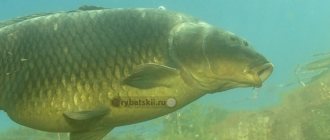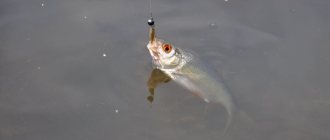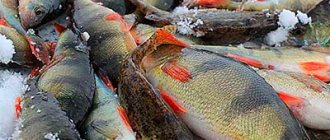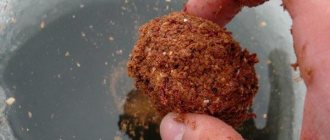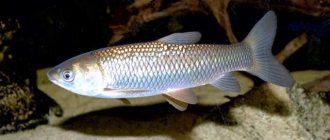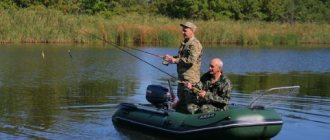Carp in September, October and November
Autumn is gradually coming into its own. The water becomes cooler, and the carp’s food supply decreases. In reservoirs of different sizes and characteristics, these processes occur differently. The behavior of carp can be summarized based on the weather conditions of the autumn months:
- September. It should be noted that this is the best autumn month for carp fishing. In September, carp are highly active during the day. During the day, it moves above the bottom surface in areas with differences in depth (from 2 m), in which its main food is concentrated: benthic organisms. At night it can go into shallow water, so fishing for carp at night is more promising compared to daytime fishing. A good sign of the presence of carp are coastal drops (cliffs) with lush surface and coastal vegetation. You should not ignore the reed islands located at a distance from the shore;
Should be considered! At any time of the year, carp avoids fast currents and is not found above a rocky bottom.
- October. In the first half of October, the behavior of carp is not much different from September. Although this happens on relatively warm days. In October, carp look for water insects that have not yet had time to burrow into the mud. It is more often found in recesses near reed thickets and in coastal cliffs. It can also be “accustomed” to a certain place with bait, thrown within 2-4 days. Reacts well to bait on the day of fishing. The carp bite in October is unpredictable. The beginning of the intense bite is impossible to determine. This happens differently in each body of water. From the second half of October, the fish begin to move to deep holes in which they will survive the freeze-up period;
- November. In November, carp stop moving around the reservoir and concentrate near the wintering pits. It reacts to bait thrown in the immediate vicinity of its location. Finding carp in November can be simplified by using a boat and a fishing echo sounder. The result of carp fishing in November depends on the successful choice of fishing spot. On an unfamiliar body of water, you need to fish all the detected bottom depressions.
Carp fishing in autumn
07.11.2016 admin
The beginning of autumn turned out to be changeable in weather. The heat gave way to gusty winds and cold rains, the atmospheric pressure jumped in steeplechase style. All this only confirmed my fears - catching a predator promised to be ineffective. The first trips to the water confirmed my fears. A normal-sized pike closed its mouth tightly and stopped responding to any type of bait. The prospect of catching “grass” and hand-sized perches on an ultralight did not inspire optimism. And if I add my long-awaited vacation to all this, the picture looks gloomy.
As in any memorable story, His Majesty chance intervened. Quite spontaneously, I received an offer to go on a full-fledged carp fishing trip to a commercial reservoir. Without any hesitation or hesitation, I, of course, agreed. Thoughts about carp fishing have been on my mind for a long time, but the life of a modern spinning fisherman is full of experiments and travel. Therefore, the trip for the elusive carp was postponed until better times.
The reservoir to which our path lay was elongated in the shape of a mirror, one bank of which lay back and was littered with large trees. It is simply impossible to approach the water and sit there. Thus, only one shore is accessible to anglers.
The reservoir itself is heavily charged. The channel edge of the river cutting through it, which fills the lake with fresh water, is strewn with stumps of cut trees. Small branches of bushes are often scattered over irrigation areas. The bottom of the reservoir turned out to be sandy-clayey with local silt deposits. Aquatic vegetation is poorly represented.
Having arrived in our sector by noon, our team began unloading things and setting up camp. At the same time, gear was being collected. The weather forecast did not promise anything outstanding; During the day it is hot, at night the temperature should drop to + 13°C. The wind constantly changed direction, driving waves either along the lake or washing torn willow stems to our shore.
Our neighbors on the shore thoughtfully peered into the distance. Their faces reflected only the hopelessness that had overcome their fighting spirit, so our arrival did not bother them at all. These were not ordinary "tourists". The equipment and installed markers indicating feeding points spoke for themselves. Later, our allies on the left and right abundantly fed their sectors with grain and boilies.
It was this fact that determined our fishing strategy. There was no point in competing with the amount of food during a short fishing trip, and we went the completely opposite route. We decided to focus on limited-portion feeding of local outlets.
Our feeding mixture consisted of fractions of different sizes, tastes and smells. We have prepared a real treat for the carp. It contained hemp, corn, cut and crushed boilies, and pellets. This mixture was topped with Monster Crab syrup.
Important point. A small amount of food supplied to one point or another did not tie us tightly to it. We could cast our boilies in different places in search of spots where active fish were feeding. It was this step that was supposed to highlight our nozzles against the background of the completely fed sectors on the sides.
The first rigs went into the water long before our camp was set up. We simply decided not to waste precious time, especially since there were less than 20 hours left for fishing. Here I want to make a small digression and tell the reader about the gear used.
It is well known that modern carp fishing is a high-tech type of fishing. Alarms, swingers, rodpods, hair mounting - all these are its integral parts. These are the pillars on which this wonderful movement rests. But there are also fishing rods, reels with baitrunners, cobras, slingshots and much more.
Since modern carp fishing was not part of my plans, I did not take any gear, I was content only with what my companions had. On Troy, we had a set of 7 rods, three of which were clearly older than me and were equipped with Nevsky reels. But, as expected, they were all equipped with safe clips and hair mounts for boilies. No “makushatniks”, “nipples” and other nonsense!
Strangely, many old-school carp anglers are firmly on the defensive and do not accept modern rigs, continuing to use pressed seeds or porridge with many hooks in the old-fashioned way. No one doubts that this scheme also works, but it does not allow you to concentrate on catching large fish or weed out small things. In addition, rigs with many hooks are not safe not only for the fish, but also for the angler himself. I believe that catching carp with the number of hooks, and not with tactics, correctly created installation and the right bait is the lot of weak anglers.
Let's get back to our fishing. All seven of our rods were equipped with hair rigs. We used a variety of combinations of boilies and pelets as bait. The flavors also varied - from sweet and fruity to meaty and spicy. Two rods were loaded with a pop-up rig.
We tried to throw our montages at points as different in nature as possible. The riverbed edge, irrigation, coastal snags, plantations of flooded bushes - our boilies were everywhere. The main task for the near future was to determine the fish thunder and taste preferences of carp. We noticed several promising spots while collecting our gear - carp often came to the surface, which attracted our attention.
The first few hours of fishing showed that our chosen tactics were correct. Before dark we got three bites. One of them was successfully implemented. A small carp was tempted by a Source-flavored boilie. The other two bites ended with the fish going into a writhing state. Even using a boat did not allow us to extract them from there; we lost the carp. One thing was clear - the fish reacted to the meat, fish and spicy aromas of the bait.
But our neighbors didn’t have a bite for several hours. However, they continued to feed their sectors abundantly in the hope of fish coming out at night. We simply checked our rigs every 23 hours and brought in new portions of bait. This step was justified. Often, while reeling in, we found our rigs in writhing positions, from where they could only be removed with the help of a boat.
We recorded each fishing point and bait used in a log, thereby forming the basis for analyzing our fishing. The sun was setting towards the horizon. The bite stopped completely. Our neighbors' alarms were also silent. The air temperature dropped, forcing us to put on warm clothes. It's time to have dinner.
There is nothing better than deliciously prepared food in nature in the company of pleasant people. At the table, long-forgotten stories, interesting facts and fishing exploits of past years are often remembered. From time to time we glanced towards our rod-pods, but the alarms were silent. Very soon, tired from the road and the terribly pleasant bustle, we went to rest.
At night, we were woken up several times by bites in neighboring sectors. As it turned out, small carp weighing 2-3 kg were biting, but nothing worthy of attention was caught. We only had one bite. Such carp anglers are called “locomotives”; the fish confidently reeled in meters of fishing line.
Grabbing the rod, I felt decent resistance. The fishing line going into the darkness transmitted powerful jerks. The fish was reluctant to give in to my attempts to seize the initiative. Several powerful pulls brought the night's performance to a complete halt. The carp hid under a snag. After standing motionless for about a minute, I loosened the tension of the fishing line, in the hope that the fish would come out of its shelter on its own, but a miracle did not happen. Karp left.
After this unfortunate incident, we stopped casting rigs, allowing ourselves and the fish to rest until sunrise. Sitting on a comfortable carp cot, I peered for a long time into the starry, cloud-free night sky. Dozens of memories of the past and present flashed through my memory, like a high-speed train, again wonderful pictures of fishing adventures stood before my eyes, moments of defeat with strong scaly rivals... Only the singing of crickets brought me back to reality, reminding me of a dream that was in no hurry to visit me.
Lying idle all night with my eyes open was not part of my plans, so I put the kettle on the gas burner. We agreed to do a complete re-delivery of gear as soon as the daylight allowed us to turn off the headlamps.
In order not to waste time, I began knitting montages to quickly change attachments. This is a useful thing. A hair montage made with one’s own hand for specific boilies with new, razor-sharp hooks not only instills confidence in one’s actions, but also brings untold pleasure to a real angler.
Understanding what you are doing and why, as if predicting the result, is one of the most pleasant feelings that fishing gives to true connoisseurs. We mainly used two trimmed boilies of meat flavors on a classic hair rig with a Curve Shank hook. These are very often used by carp anglers.
With a “snowman” made from two 20 mm boilies, I wanted to cut off small fish, but not only that. Most likely, there were few carp in our zone, given the abundantly fed sectors on the left and right. The emphasis was on a large feeding bait to attract the attention of those fish that swam in front of us.
As soon as my partners woke up and had breakfast, we immediately began updating the nozzles and bringing them in. In doing so, we used several tricks, which I will discuss in more detail.
Since we used point feeding, the bait should be in close proximity to the feeding spot. That's why we used a radio-controlled boat. The advantage of this device is difficult to overestimate. It is not difficult to deliver bait and rigs to the selected point with an error of up to 1-2 m. Everything happens very quickly, quietly and without unnecessary fuss. The second assistant of a modern carp angler is an electronic rangefinder. This device looks like a pocket binocular. With its help, you can accurately determine the distance to a specific object, in our case, to a boat.
My companions were familiar with the topography of the reservoir from previous fishing trips. All our actions boiled down to choosing a landmark on the opposite bank and measuring the distance to which we wanted to bring the installation. We did all this quickly.
Ordinary binoculars will also come in handy when fishing. During periods of calm between bites, we examined the surface of the reservoir. The carp revealed themselves by silent exits to the surface or by many bubbles rising from the bottom. It was in such places that we tried to place our nozzles.
The baits of five of the seven rods were placed along the channel ditch on either side of it. There was a hard bottom, decent depth, stumps from felled trees. The combination of these conditions should not have remained out of sight of large fish. The sixth installation was brought directly under the opposite bank and lowered into the water near the fallen trees. The fishing distance exceeded 250 m.
I insisted that the sixth rig be brought into the very snag in which there was a night bite that ended in an unfortunate disappearance. That place had a bad reputation on the reservoir due to the large number of snags and broken gear. But, remembering the fishing proverb “where there are cramps, there is grub” and my personal successful experience of fishing in the right, and not convenient for fishing, places, I put the bait between the snags, using one little trick.
Firstly, I replaced the heavy 130-gram sinker with a lighter one, weighing only 90 g. Secondly, the rubber cone casing that fixed the eye of the safety clip with the sinker was not put on very tightly, only a third of its length. According to my idea, after biting, the carp should have impaled itself on the hook and in a moment freed itself from the sinker, tearing the loosely attached cambric off the clip. In turn, after hooking, the hook enters the lower lip thoroughly, and the fish, without feeling the additional load that constantly pulls it to the bottom, behaves more obediently when fishing.
On the one hand, this may seem wasteful, because losing a sinker on every bite is a luxury, especially in this day and age. But on the other hand, situations of this nature are quite rare on paid reservoirs, and biting the desired fish will more than cover the loss of an element of equipment. Some fishermen in such situations use the so-called “breakaway sinker”. In other words, instead of the usual one, use a small stone weighing no more than 400 g.
Such an installation cannot be cast with a fishing rod, but it will not be difficult to bring it on a boat and accurately place it on the selected area. The main advantage of this technique is the ability to catch fish where it is difficult to reach. Without a sinker in the rig, the carp behaves completely differently. The fish does not tend to the bottom and very often goes to the upper layers of the water, where the chance of getting a fishing line into a drowned tree is minimal.
After installing the last rod on the stand, the countdown began; by noon we planned to leave the fishing spot. We had a beautiful carp weighing 5 kg, and three fish lost in snags. To be honest, I pinned my main hopes on the morning bite.
The first bite happened as soon as the sun rose above the trees. The fish bit the rod I had set in the snags. After hooking, the sinker, as intended, came unfastened. This immediately became clear from the behavior of the fish. The carp moved very quickly! He passed over three of our fishing lines without touching any of them. This once again confirms that without a sinker in the rig, carp are more willing to go to the upper layers of the water.
My opponent was not going to capitulate, twice the reel’s drag sounded a pleasant crack, giving away meters of fishing line into the distance. Since the fish quickly left the risk zone and reached a flat plateau, I did not force the landing. After two unsuccessful attempts, the carp, exhausted from the struggle, allowed itself to be caught in the landing net.
This was my victory! It was not the size of the trophy, but the fact that my idea came true, and here in my hands is a bronze beauty weighing just over 7 kg. A detailed examination showed that the lips were intact, which means that, most likely, this carp had never been hooked before. Perhaps the snags in which he was caught served him as a safe refuge. After being weighed and taking a few photographs, the fish was freed.
Without the slightest delay, I assembled a similar assembly and placed it at the same point with a new portion of bait. Looking ahead a little, I will say that I was unlucky with the location of the equipment. Finishing fishing, the rig was found tightly seated in the cramp. Still, by placing gear in strong places, the fisherman always takes risks.
After such a pleasant trophy, which woke up our sleepy heads and filled our hearts with optimism, it was time for breakfast. Freshly brewed coffee in nature is a thousand times tastier than usual! And the taste of scrambled eggs with fried bacon and fresh vegetables energizes you for what seems like a whole day. Our wonderful meal was interrupted by the crackling of the Nevskaya coil. The bite occurred on a bait located near the riverbed ditch. “Oh my God, someone fell for this junk!” - Alexander Viktorovich muttered dissatisfiedly, slowly getting up from the table.
The old fishing rod lay motionless on the grass, showing no signs of activity. At first we thought that a small carp was playing with the bait. This often happens when you put two 20mm boilies. Small fish are interested in the bait, but cannot swallow it. All these games continue until the annoying little thing loses interest, or until it somehow gets hooked.
The line going into the water sagged a little. Having exhausted the slack, Viktorovich made a short sweep. The iron whip bent under the load, the fishing line rose from the water. Watching from the side, it was hard for me to judge whether there was even a fish on the hook. But the heavy movement of the reel and the fishing line going to the side dispelled my doubts, I turned on the camera. The incident was at least promising for an interesting shot, since you don’t always get the opportunity to fish with such antiques.
Under the pressure of the fish, the reel creaked pitifully, as if reminding us of old age. Three pass rings formed a broken curve of fishing line, which loaded the metal form. And this was considered the standard tackle many, many years ago! Now we prayed to God that this miracle tackle would withstand one more fishing, because with every meter of fishing line taken, Viktorovich never tired of repeating to us: “There is something good there!”
A few minutes later, being already close to the shore, the carp turned its powerful body with lightning speed and, waving its tail, immediately took a couple of tens of meters of fishing line from the reel. And here I cannot help but note the coordinated actions of our hero. Fighting with a carp larger than average while holding a Neva reel in your hands is not a pleasant pleasure. When jerking, anything can happen, from bloody fingers to line tangling and loss of fish. But no one can cancel the experience of a fisherman! It is at such moments that you realize that the main factor influencing the results in fishing is still the fisherman! No benefits of civilization will ever replace a person and his experience.
Having barely had time to stop this throw of the “beast” striving for freedom, Viktorovich, with all his strength, tried to lift the carp up so that the fish would pass over our fishing lines. Such a maneuver was very difficult, because the “height” of the rod barely exceeded 2 m. Despite the long struggle, the carp did not want to approach the shore, where Roman was waiting for him with a landing net lowered into the water. However, gradually the strength left this wonderful fish, and soon it was taken.
The fish was seduced by the bait of two trimmed BRAIN Diablo boilies, the hook, according to the classics, was securely seated in the lower lip. A huge mirror carp, covered with a landing net, lay peacefully on the mat. Its back was reinforced with armored scales, like the shield of a prehistoric animal.
We couldn't believe our luck! Such an incredible and long-awaited fish. Until the carp came to its senses and started fighting on the shore, I managed to take a few photos. From time to time we doused the fish with water, preventing the skin from drying out in the air. A moment later, the trophy was transferred to a carp bag, everyone was tormented by the question - how much does it weigh?! Before weighing, we voiced our assumptions out loud, but many were deceived by our eyes... I really wanted to believe that he weighed more than 20 kg. But the scales cooled the bold assumptions; the weight of the carp without a wet bag turned out to be 18 kg.
A carp weighing 18 kg, caught with a Leningrad spinning rod and a Nevskaya reel! This was not just a result, but, without exaggeration, a record. It became possible thanks to the correct fishing strategy, impeccable fishing and teamwork. After congratulating each other, we gave this fantastic fish freedom. Without unnecessary fuss, waving goodbye to us with a tail as powerful as a shovel, the carp went into the depths. It is difficult to describe in words how the fisherman feels at such moments. Perhaps it can be compared to shaking hands with your opponent in the ring after a hard victory.
Our strategy has produced amazing results. We achieved six bites, three of which ended in catching a qualifying fish. A little later it became known that a new reservoir record had been set. Surely we could have caught better, but it’s hard to complain - the fishing turned out to be thoughtful, intellectually interesting and memorable. This is how real carp fishing should be!
These articles may interest you
- Fishing for lenka in the Khabarovsk Territory on the Amur River
- How to fish with jigs
- How to solder a regular tin jig
- How to make a winter pole from a fishing rod
- Winter fishing with girders in shallow water
- Catching perch in winter with a jig
- Fishing in the region: Moscow region
- Fishing in seasons: autumn
- Fishing: open water
- Articles about fishing
Recent Entries
- Fishing with dragnet
- Making Carolina rigs for pike and perch fishing
- How to equip a Volzhanka 46 Fish boat for fishing
- Winter fishing in Finland, what and how
- About setting up the jig when assembling winter tackle
- Fishing on the Tura River in winter in February
- The A-elita vent is visible from afar
- Winter lure “A-Elita” is the best of all
- How to attach a float rig to a fishing rod?
- Installation of float equipment for fly and plug fishing rods
Advanced site search
Group 1 below in site entries
Carp on the feeder
A modern donkey for carp - the feeder is the most popular gear for carp fishing. It is important to choose the right rod and equipment that allows you to fight large and strong fish.
For carp fishing, a feeder rod about 4 meters long is suitable. Class - hard or medium. Build – fast or medium. Particular attention is paid to the strength of the fishing rod. High-quality branded models usually correspond to the stated characteristics.
Select a fishing line or cord with a load capacity of 10-15 kg. But this does not mean that a high-quality fishing line with a reserve carrying capacity allows you to perform forced fishing for large carp. The jerking of the fish in attempts to free itself from the hook can tear the strong equipment or provoke a rupture of the fleshy lip of the carp.
It is important to choose the right reel for the feeder. When retrieving caught fish, a reel is always involved. A correctly adjusted clutch will itself “determine” the maximum tension and release the line.
Feeders with large capacity are selected for feeders. It is unrealistic to overfeed a freshwater giant, but it is possible to keep it in a feeding area. You can use a purchased mixture or prepare your own bait for carp.
Durable types of fish hooks are used to catch carp. A low-quality hook can bend or break due to the fierce resistance of a large carp. Hook size - No. 10 according to domestic numbering. For the convenience of planting a large bunch of baits (attachments), products with a long fore-end are applicable. Self-hooking is facilitated by hooks with a sting curved inward. The length of the leash(s) depends on the method of rigging the feeder.
Features of carp fishing tactics in autumn
The basis of this tactic is the peculiarity of carp behavior in the autumn. Firstly, it is not so active, and secondly, large numbers of carp may accumulate in certain areas of the reservoir. Based on this, we can say that there are both pros and cons. If the reservoir is familiar and the fisherman knows the bottom topography perfectly, then there will be no problems with fishing, unless weather conditions interfere. If the reservoir is unfamiliar, then problems are guaranteed, since it is difficult to determine the concentration of fish, unless you use an echo sounder. Otherwise, it is unlikely that you will be able to lure the carp to the fishing spot.
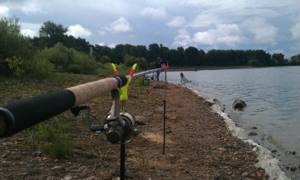
Since carp activity is reduced to a minimum, it is necessary to change bait tactics. Since fishing is done in cold water, one or two kilograms of bait per day should be enough. At the same time, it is necessary to make a starting cast of bait to the fishing point, but in much smaller quantities. During this period, the carp's appetite is weak and it eats only what it needs. After all, winter is coming and you need to not only eat, but eat in such a way that you can stock up on nutrients for the winter.
When using bottom gear or a feeder with a feeder, you should use smaller feeders and at the same time maintain the optimal fishing pace. For this period, 4 casts per hour are sufficient. This will allow you not to get carried away with feeding the carp, and you will also have time to select baits and use dips.
If we talk about baits, then carp are not against eating selected worms, but only a part of such worms can get into the autumn diet. Considering this circumstance, in the autumn you can switch to bloodworms, placing several pieces on the hook at a time. Alternatively, you can use silicone rings to tie several bloodworms into one nice bunch. It is especially worth dwelling on flavorings, without which modern carp fishing simply does not make sense. Of course, it is necessary to add flavorings, but you should take into account the autumn specifics of fishing associated with fishing in cold water. If you add too much flavoring, it may not only not interest the carp, but also scare it away. This is especially true when fishing in bodies of water where there is no current. When fishing in the current, this is not so important.
The use of flavorings is associated with changes in fish nutrition. In the autumn, the fish switches to a diet in which animal components predominate. Therefore, flavorings should be dominated by the corresponding odors: worm, bloodworm, fish, maggot, etc. At this time, the smells of the summer period, such as fruity and sweet sap, are no longer effective in the autumn period.
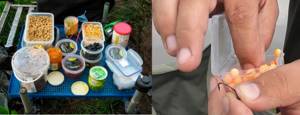
The option of adding bone or fish meal, blood, milk powder or ground zebra mussel to the bait will not be very expensive.
Without the presence of components of animal origin in the bait, you should not count on a successful fishing outcome. This applies primarily to “wild” reservoirs, where carp are in natural conditions and feed on what they can find in it. As for paid reservoirs, everything is different here. The feeding preferences of the food in such a pond depend on what it is fed, although there is no particular secret. In this case, fishermen, going to a paid reservoir, practically know what carp can be offered.
As you can see, autumn fishing, including carp, is an interesting, but very difficult business. At this time, it is difficult to count on a positive result if you do not have certain skills and appropriate equipment. Skills are necessary in order to be able to find a suitable place, and there is no way to do this without knowledge. It is necessary to know, first of all, the habits of carp, especially in the autumn. Of no small importance is the knowledge obtained as a result of examining the topography of the bottom of a reservoir, especially an unfamiliar one. Knowledge will also be needed in the process of selecting gear: from the rod to the hook. After all, everyone knows that special carp hooks are used when fishing for carp. And so, no matter what: it’s better to take a braided fishing line, since it has a high breaking force, with the same diameter. At the same time, thinner fishing line is easier to cast over a long distance. And that is not all! Braided fishing line has a specific stretch, which means that it will transfer the slightest bites to the tip of the rod.
Carp on an elastic band
The classic rubber band tackle is used for catching carp from the shore. The tackle can be upgraded by installing a feeder or spinning rod with a reel. A quality Bolognese rod is also suitable.
Carp can be successfully caught with rubber bands from the shore and boat. Fishing with a rubber band from a boat has its own characteristics. If there is a chance of catching a large carp, then it is better to go out together for targeted fishing from a boat. Fighting large carp can present various unpleasant surprises.
Bait for carp fishing in autumn
The best, and not very expensive, option for carp bait is a wheat-cake mixture, the effectiveness of which is due to its strong odor.
To prepare this bait you will need flour, sugar and eggs. Before thoroughly mixing all the ingredients into a homogeneous mass, it is recommended to lubricate your hands with sunflower oil. After this, the mixture is left alone for one to two hours. Then the resulting mixture is rolled into sausages and dipped in boiling water for 35–40 seconds. You need to rub the cake or wheat gluten into the hot bread obtained in this way. The prepared product is left overnight in the bag at room temperature. After arriving at the fishing spot, the mixture is crumbled or cut. This is how you get a wonderful carp bait!
Carp on a float rod
Carp can be successfully caught on a float rod in coastal cliffs, from a boat and at night. A match fishing rod can also be used for long-distance fishing. An rig with a sliding float helps increase the casting distance of a traditional fishing rod and reel.
When equipping a float fishing rod for carp, it is necessary to pay attention to the strength of all elements of the tackle. Considering that carp are very careful, to catch them, especially in clear water, you should take care to camouflage your gear. The fish will not approach the bulky fishing rod equipment even during periods of high activity. The best option for a float fishing rod is fluorocarbon line. It is invisible in the water and does not float when fishing from a steep bank or during a side wind.
Preferences of carp in late autumn
With the onset of frost, the carp becomes passive, stops feeding, and moves to its wintering place. The bite almost stops at this time. But there are little tricks to catch fish in November:
- Use as bait for worms, maggots, bloodworms, high-protein boilies, crayfish meat, squid, etc.;
- Corn and boiled potatoes soaked in fish oil are very successful baits for carp in November;
- Use flavored bait for cold water;
- The bait should be multi-ingredient;
- Feed the carp more often and more than in summer;
- Reduce feeding area.
Read: Choosing a place and bait for catching catfish
Fishing for carp in the fall is a very pleasant and exciting pastime. The main thing is to be prepared for the taste vagaries of fish and the vagaries of the weather.
Subscribe to
our channel in Yandex Zen
Carp on mugs
On a large river, reservoir or large lake it is difficult to locate carp, even when they are highly active. In such conditions, carp fishing with circles is applicable. But there is one condition - the presence of a boat.
Important! You should not use watercraft such as inflatable tubes without an anchor. Large carp can carry such a floating device throughout the entire water area until it enters thickets or bottom snags. As a result, retrieving large fish will become impossible.
Circles for carp are placed in promising places. The main thing is that they are in sight. Do not overuse the amount of this gear. The optimal option is 8-10 pieces.
Carp routes
Often, catching this fish at such a wonderful time turns out to be ineffective for one simple reason - the angler made a mistake in choosing the place. He simply threw his gear in a place where carp never appear in the fall. For example, in a shallow, clean area with a depth of no more than 1.5 meters. It is unlikely that you will be able to find it here, since as it gets colder the water becomes clear, and such a large representative of the ichthyofauna becomes too noticeable.
Where can you catch carp in September? There are many suitable places on a pond or in a river. These include:
- deep river backwaters;
- return lines with slow flow;
- areas overgrown with vegetation, next to which the depth begins;
- pits, dumps and other bottom depressions from 3 to 5 meters.
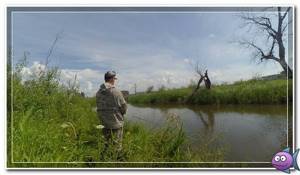
At such points the object of fishing appears most often. You can go two ways:
- identify 2-3 promising places and try to catch them one by one;
- choose one, feed it well and wait for the fish to approach.
An important point in finding carp is taking into account the nature of the bottom. He likes to dig in soft muddy soil, but usually avoids areas with hard rocky or sandy surfaces.
What do carp bite on in the fall?
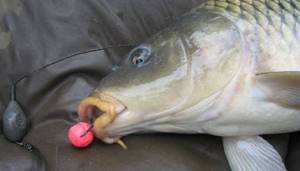
The important question of what carp bites in the fall does not have a clear answer. You have to be guided by the experience of practical fishing. The taste preferences of fish are constantly changing. Before going out onto the pond, you need to stock up on all available baits and carp baits. It should be noted that in the first half of autumn, it is necessary to give preference to plant baits, and in the second half – to baits of animal origin.
Baits for carp
- Dung worms. To attract large fish, they are attached in a bunch. This method of baiting reduces the likelihood of small fish pulling the bait;
- Maggots. To catch carp there must be at least 3 of them on a hook;
- Crawls. In autumn they can be prepared after heavy rains;
- Shellfish meat;
- Bloodworms. To prevent the bait from leaking onto the carp, use a jig with a clothespin or tie a bunch of large bloodworms directly under the hook;
- Caddisfly larvae.
What to feed carp in early autumn?
When it is still warm, sunny and not so hot outside, the carp begins to eat. This is until about mid-October. The best baits during this period will be grains and protein contained in live bait:
Read: How to prepare boilies yourself? Recipes for effective attachments
In warm autumn weather, fishermen use bread, dough, and semolina. But as soon as frosts begin, preference is given to protein bait. Another trick fishermen use is to flavor their bait. Fish oil, special flavored oils, attractants, and dips are often used for these purposes. Preference is given to natural scents:
- garlic;
- hemp;
- honey;
- dill;
- fish aromas;
- aroma of sunflower cake.
Groundbait in early autumn should consist of a large number of components, because at this time food preferences change very quickly.
Crucian carp in September. Features of behavior
The behavior of crucian carp in September depends on the climatic conditions of the region. In the central and southern regions, the weather in the first half of the month differs slightly from the weather conditions in August. A noticeable decrease in temperature has been observed since the second half of the month. Throughout September, the night temperature may differ from the daytime sun by 15-20 degrees.
Crucian carp is sensitive to temperature changes and changes in atmospheric pressure. In the first half of the month, when the temperature reaches 30 degrees, the fish moves to bottom recesses or hides in shaded areas of the coastal zone. There is still enough food during this period, and therefore the fish do not scour the reservoir in search of it. On such days there is a deterioration in the bite.
In the second half of September, night temperatures increasingly drop below 10°, and daytime temperatures rarely reach 25°. The algae gradually die off, and aquatic insects begin to burrow into the mud. The food supply for crucian carp is becoming scarcer, and this factor forces the fish to become more active in search of food. This is the best period for catching crucian carp in September. The bite is observed with varying intensity during the day and at night. When fishing at night, the likelihood of catching a trophy crucian carp increases.
September carp
There is a long, cold winter ahead and the fish, sensing its approach, begin to actively feed, fattening up and preparing for a long winter hibernation. Among all the trophies available for fishing in September, it is worth highlighting carp, whose bite increases. This domesticated form of carp is a solid catch!
In addition, the right time is coming for carp fishing - carp begin to eat in September, which will last until the first frost. So, pack your gear and go to the pond - carp fishing in September is considered one of the most productive. Just don’t forget animal bait - due to lower water temperatures, carp begin to peck more on live bait.
Tips for carp fishing in autumn
There are features of carp fishing in September, which we will try to highlight in the light of the above and present them in the form of advice to anglers.
- Carp is already a very cautious fish, but in the conditions of autumn clearing of the water, its timidity increases many times over. Therefore, when fishing, good camouflage on the shore is important: choosing suitable clothing and avoiding unnecessary movements.
- Particular attention should be paid to silence on the shore or in the boat. The fish is not so much afraid of human voices as of the stomping of feet and other impacts on the ground, the vibrations from which are transmitted under water.
- When fishing for carp, it is mandatory for the fisherman to have a strong, large landing net. It is this device that will help at the last stage of landing a large trophy.
- Large boots or waders will also help when fishing, this becomes especially important when fishing from a sloping bank. The need to enter the water in such places is explained by the fact that, sensing shallow water, the carp is able to make a particularly strong jerk.
- Reliable stands for rods and a reel with a baitrunner will protect your gear from being “kidnapped” by large and strong fish.
- You should not force the carp to fish; you need to let it get tired. To do this, the angler must deftly operate the reel clutch, setting the force at which the fish can tire.
- On the other hand, you should not give the carp even the slightest slack in the fishing line; this also risks the trophy falling off.
If there are no bites for a long time, you shouldn’t just sit and wait for the weather by the sea, but act actively:
- vary the options for nozzles, combine them;
- reduce the thickness of the leash.
